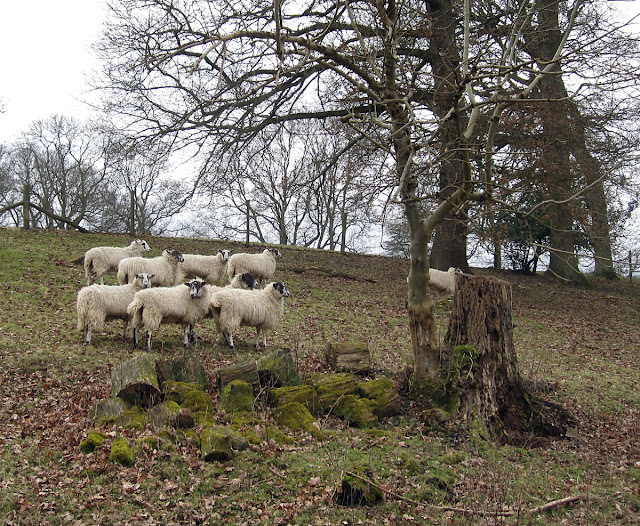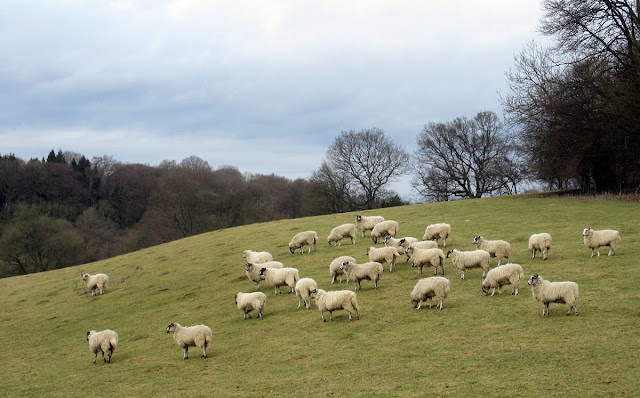 |
| Scarlet elfcup, Sarcoscypha coccinia. 18 February 2012, 11.37 am. |
This is part two of my notes of a walk by the Orpington Field Club on Saturday 18th February. To recap briefly: we followed public footpaths around Knockholt; all these photos were taken with an Ixus 100; I am showing them in chronological order to give a sense of the walk.
The Scarlet Elfcup above was probably the star of the day. We saw two specimens in different parts of the wood; this was the first. It is small, but vivid, and is normally regarded as a better poster child for fungi than the more common black, brown and yellow jellies and the various brackets and crusts that can be seen in this season.
Further on we passed a couple of giant redwoods, certainly not native. They look imposing among our trees, though nowhere near the height and bulk they achieve in the USA. A fallen branch gave me the opportunity to see the scaly leaves and the ripening cones, which look like a bunch of lips.
 |
| Leaves and cones of a Wellingtonia, Sequoiadendron giganteum. 18 February 2012, 12.02 pm. |
The walk leader pointed us to a clump of Velvet Shank, a pretty fungus that can withstand being frozen solid, unlike most soft mushrooms. It was near here that we found the second Scarlet Elfcup.
 |
| Velvet Shank, Flammulina velutipes, in Vavasseur's Wood. 18 February 2012, 12.04 pm. |
Soon afterwards, we stopped for lunch in Vavasseur's Wood, named after a 19th century silk merchant. While the others sat on logs and at a picnic table, I nosed around and photographed this tree streaked with the orange alga Trentepohlia, which is quite common. It's by itself here, but Trentepohlias can also combine with fungi to form various lichens. We had a quick burst of sunshine just in time for me to capture this vivid shade, which is caused by carotenoids, chemicals from the same group as those that colour carrots.
 |
| Trentepohlia on a tree trunk in Vavasseur's Wood. 18 February 2012, 12.13 pm. |
There were some primroses in flower, too, but I didn't get a decent photo. I did find this common puffball, still full of powdery spores that puffed out, at a touch to the papery top, in greenish clouds that floated off in the breeze. It was sheltered under a tree, so probably escaped the snow.
 |
| Common Puffball, Lycoperdon perlatum. 18 February 2012, 12.20 pm. |
Then I found this skull, which used to belong to a Roe Deer (that's my best guess, anyway). It's in quite good shape, and I passed it on to the Field Club for our collection.
 |
| Skull of a Roe Deer, Capreolus capreolus, found in Vavasseur's Wood, Knockholt. 18 February 2012, 12.31 pm. |
While I was mooching around, I heard a series of crashes as a branch fell from a nearby tree. It seemed to be sprinkled with small, shallow, white cones, which when I got closer turned out to be the undersides of small fungus brackets, perhaps Turkeytail again (there's a photo in Part 1), this time a new growth.
 |
| Small brackets, perhaps a fresh growth of Turkeytail, Trametes versicolor. 18 February 2012, 12.33 pm. |
So my lunch period was quite productive! Afterwards, we left the woods and walked down Blueberry Lane to a path over some hilly fields full of sheep. This was delightfully pastoral, though we had to negotiate several high and awkward stiles to follow the path. At first the sheep just ran away, but after a few minutes they would at least stand still and look at us.
 |
| Sheep in the fields near Knockholt, 18 February 2012, 1.17 pm. |
 |
| Sheep in the fields near Knockholt, 18 February 2012, 1.18 pm. |
And now we were nearly back to the churchyard from the opposite direction. I saw a Green Woodpecker flying low in a neighbouring field, and picked up some pheasant feathers as we walked along. We came past the rear of a large house, which I see from the map is called Court Lodge and, from web sources, appears to be a childrens' home. At the end of the long lawn is this classically-inspired folly.
[Photo removed at the request of the householder.]
At this point it was getting darker and starting to rain; the walk had been timed perfectly. We passed though a garden with several exotic trees, including one which looked like an evergreen willow, then back through the churchyard and away. A very pleasant and interesting walk.









I like follies. And the fungi you found are wonderful. Your redwood cones, however, one of my favorite cones, are just like ours. I like them all sealed and green before they open to release their seeds. Seems to me the Ixus also likes overcast and about to rain.
ReplyDeleteI was one of the first child residents of Court Lodge when The Church of England Children's Society first used it as a children's home in 1964, prior to this it had been a Fairbridge home from where child migrants were sent out to the colonies. I understand the house has been a private family home since around 76 or 77. I have to say though that I do not recall that folly being there back in the sixties, we would surely have played there.
ReplyDelete